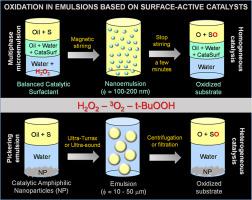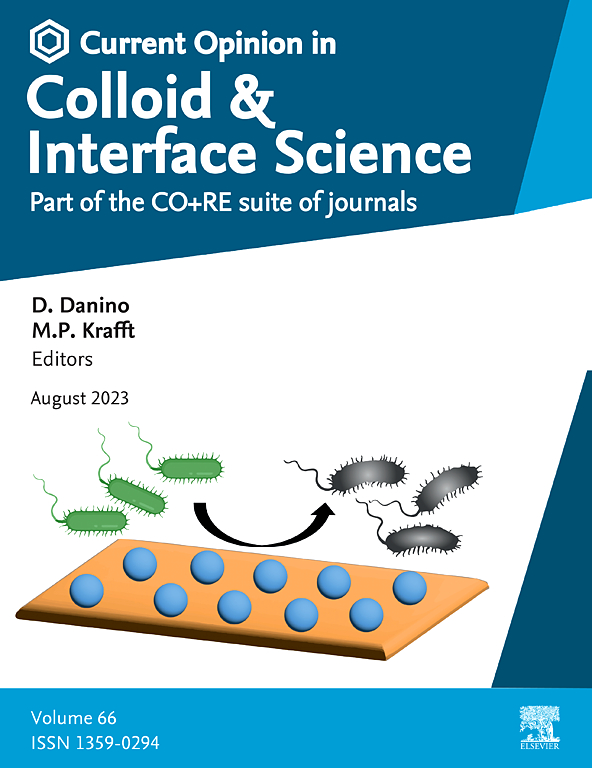表面活性分子和纳米颗粒催化剂在乳状液和微乳中液液界面氧化的研究进展
IF 7
2区 化学
Q1 CHEMISTRY, PHYSICAL
Current Opinion in Colloid & Interface Science
Pub Date : 2025-08-11
DOI:10.1016/j.cocis.2025.101952
引用次数: 0
摘要
本文综述了在乳化双相体系中使用初级氧化剂(O2、H2O2和t-BuOOH),通过表面活性分子或纳米颗粒催化剂进行催化氧化的最新进展。重点放在活化这些可持续氧化剂的氧化还原催化剂兼容的水双相环境。这篇综述的一个显著特点是其以胶体为焦点的观点,研究了表面活性催化剂/油/水体系的配方和组成如何影响乳液形态、液滴大小、脱混动力学,以及最终产品回收和催化剂回收的便利性。特别关注的是氧化还原活性两亲体的设计,它可以增强界面覆盖并促进(纳米)乳化。考虑了三类系统:(i)使用单独的相转移剂(pta)和氧化还原催化剂的系统;(ii)涉及催化表面活性剂或催化离子液体(CILs)的集成系统,在单一物种中结合界面和氧化还原功能;(iii)两亲性纳米颗粒,吸附在油水界面,既可作为乳状液稳定剂(所谓的皮克林乳状液),又可作为氧化催化剂。一个专门的部分解决了有机合成中化学生成单线态氧(1O2)的挑战。由于其在水中的寿命很短(≈4 μs),因此在失活发生之前,微乳液体系的水纳米液滴中必须产生1O2以确保其扩散到有机相。最近在Pickering界面催化(PIC)方面的创新突出表明,颗粒基系统在控制乳液的物理化学性质和提高催化性能方面正变得越来越复杂。然而,在将其扩大到工业应用之前,仍有几个挑战需要克服。本文章由计算机程序翻译,如有差异,请以英文原文为准。

Recent advances in interfacial liquid–liquid oxidation in emulsions and microemulsions with surface-active molecular and nanoparticulate catalysts
This review presents recent advances in catalytic oxidations performed in emulsified biphasic systems using primary oxidants (O2, H2O2, and t-BuOOH) mediated by surface-active molecular or nanoparticulate catalysts. Emphasis is placed on the activation of these sustainable oxidants by redox catalysts compatible with aqueous biphasic environments. A distinctive feature of this review is its colloid-focused perspective, examining how the formulation and composition of surface-active catalyst/oil/water systems drives emulsion morphology, droplet size, demixing kinetics, and ultimately the ease of product recovery and catalyst recycling. Particular attention is given to the design of redox-active amphiphiles, which enhance interfacial coverage and facilitate (nano)emulsification. Three classes of systems are considered: (i) systems using separate phase-transfer agents (PTAs) and redox catalysts; (ii) integrated systems involving catalytic surfactants or catalytic ionic liquids (CILs) that combine interfacial and redox functions within a single species; and (iii) amphiphilic nanoparticles that adsorb at the oil–water interface, serving as both emulsion stabilizers (the so-called Pickering emulsions) and oxidation catalysts. A dedicated section addresses the challenge of chemically generated singlet oxygen (1O2) in organic synthesis. Due to its short lifetime in water (≈4 μs), 1O2 must be generated in aqueous nanodroplets of a microemulsion system to ensure its diffusion into the organic phase before deactivation occurs. Recent innovations in Pickering interfacial catalysis (PIC) highlight that particle-based systems are becoming increasingly elaborated, both for controlling the physicochemical properties of the emulsion and for enhancing catalytic performance. However, several challenges still remain to be overcome before they can be scaled up for industrial applications.
求助全文
通过发布文献求助,成功后即可免费获取论文全文。
去求助
来源期刊
CiteScore
16.50
自引率
1.10%
发文量
74
审稿时长
11.3 weeks
期刊介绍:
Current Opinion in Colloid and Interface Science (COCIS) is an international journal that focuses on the molecular and nanoscopic aspects of colloidal systems and interfaces in various scientific and technological fields. These include materials science, biologically-relevant systems, energy and environmental technologies, and industrial applications.
Unlike primary journals, COCIS primarily serves as a guide for researchers, helping them navigate through the vast landscape of recently published literature. It critically analyzes the state of the art, identifies bottlenecks and unsolved issues, and proposes future developments.
Moreover, COCIS emphasizes certain areas and papers that are considered particularly interesting and significant by the Editors and Section Editors. Its goal is to provide valuable insights and updates to the research community in these specialized areas.

 求助内容:
求助内容: 应助结果提醒方式:
应助结果提醒方式:


